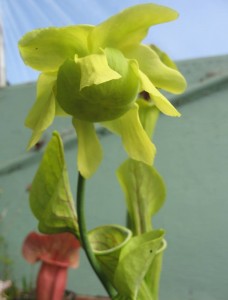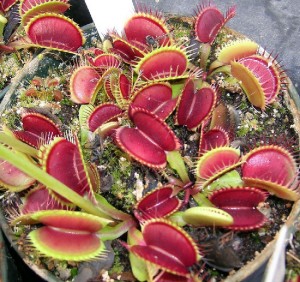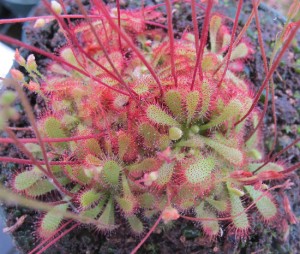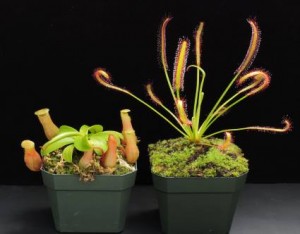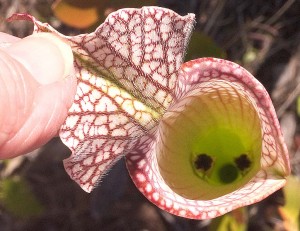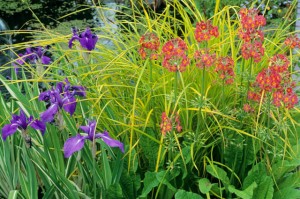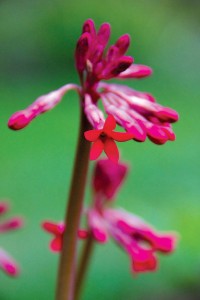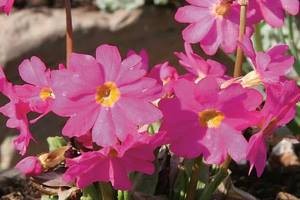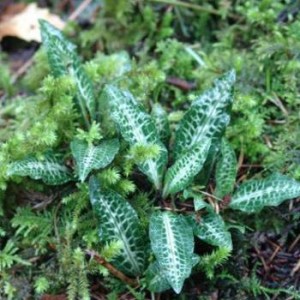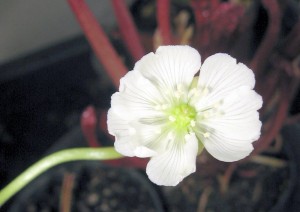What am I buying now? Sarracenia plants! – houseplants that provide organic bug control.
‘Sarracenia’ was first employed by Michel Sarrazin, the Father of Canadian Botany – 17 Century stuff and Linnaeus agreed to that name.
Like bonsai, their roots are susceptible to nitrates so I will dilute the fertilizer regime accordingly. Then periodically flush with rain water … or put them out in those rare summer rains we have. I could not bear to see salt burns on these plants.
- Many customers who buy Venus Fly Traps or Sundews water them with chlorinated and fluoridated water. This is the kiss of death. Clean water is imperative, even using distilled if it came to that. Cheaper than Perrier of course. Filters don’t take out some of that stuff. More on VFT care.
2. Wrong fertilizers would be my next guess for their houseplant demise. Nothing new there. If a houseplant starts to go downhill, water it more … and fertilize it back to health. ![]() 🙁
🙁
3. Not allowing them to cool down and go dormant during winter would be another causative factor for repeat purchases.
4. Last would be the forced feeding of bugs or filling those tempting pitchers full of water.
A few basic facts: “Most of the species have erect and tubular pitchers. The pitchers are modified leaves. Insects are attracted to the pitchers because they mimic flowers—the pitchers are brightly colored, and are endowed with sugar-exuding glands called extrafloral nectaries (i.e. nectar sites that are not in flowers). It is significant that the pitcher coloration and distribution of nectaries are usually strongest near the pitcher opening—a dangerous place for incoming insects!
The bottom of the pitchers is filled with fluid (sometimes lacking in plants cultivated in less-ideal conditions). These fluids are filled with digestive enzymes, although I do not know if this has been verified for all species, and also a great number of hungry creatures ranging from bacteria to the larvae of mosquitoes, midges or fresh flies. These help consume and digest the captured prey”. I hope they also work on fruit flies.
“A mature plant in mid-winter often looks old and miserable. Its pitchers are tattered by a long season of work, or may be burned back by fires. With the resumption of spring growth, the first thing the plant does is make flowers. These flowers are harmless to insects, and even reward pollinators with pollen and nectar just as conventional, insect-pollinated flowers usually do. Once pollination is over, the plant produces its new crop of carnivorous pitchers as it shifts its relationship with insects from kindly to cruel. It eats bugs all summer long until the pitchers die back in the fall. As the pitchers shrivel, they translocate nutrients from the leaves back to the underground rhizome. Meanwhile, the fruit on the flowers split open, and scatter seed.” From Wikipedia.
I await further instructions from the grower and will amend this with further updates. Overwintering them in a heated and low humidity home will kill them. So out they go into my cold greenhouse until next spring.
LINKS!
A Pt. Townsend Nursery! Far Reaches Farm
eBay seller -(damonnormal99) Exceptional
base_cactus_and_succulents.– eBay sells Sarracenia, Venus fly traps and more.
Wholesale WA grower – Courting Frogs Nursery
Retail CA supplier – California Carnivores ** No personal experience
Detailed Venus Fly trap, Sundew and Pitcher plant growing instructions from Cooks.
Propagation of Sarracenia seed
International Carnivorous Plant Society
The Sarracenia forum – a blog.
Sarracenia species and hybrid FAQ
Still worried about slugs! After eating the babies, with my luck they will climb the mother and then my three foot S. flava will be slimed. Trouble is they may starve in my house. I have been watching my one fly and it has not decided to commit seppuku. They will go outdoors after all. Best of all, I now have room to add Venus fly traps and Sundews as understory plants. In the meantime I now have room for their present to me.
Update: All too soon! I had made two nice bog planters next to my house, wind protected and open to the sun. Then I read the instruction booklet. All of these guys like 70 to 90 F. summer temperatures. Sequim simply does not have that. Heck, if we get two weeks of 80 degree weather people begin to wilt.
So my two little greenhouses found themselves home to ‘bog plants.’ Today, I tried to add some flower power by adding accessory plants. I had found one water primrose that had been overlooked for five years in another nursery. Trying to divide it was interesting. Solid pure blue clay and the water imprisoned primula kept hoping for salvation. Now there are five. Mind you, most water/bog plants being sold are WEEDS and some are noxious, and the state has to mitigate your releases when they escape. True primroses do not fit that category. Following are a few suggestions for moisture loving primroses. These are not however meant for either bog or water gardens.
Today I also divided and planted some native ground orchids I had. GOODYERA OBLONGIFOLIA also known as Rattlesnake Plantain and happily planted three Darlingtonia californica that I bought from Courting Frogs Nursery. Darlingtonia are tough plants but they do have an Achilles heel. As much as possible try to grow your mature Darlingtonia outdoors or in a cold greenhouse. Or in my case a cold but well lit house. Plenty of sun and you need to keep the roots cool. I provided that by putting them in a large tray with cool water. Replenishing that standing water is important as they are more used to dripping or moving water. NO Fertilizer and do provide a soil mix that will not muck up. Coarse builders’ sand added to the sphagnum will keep them happy.
(C) Herb Senft 2015
My other sites begin with the discussion: ‘Sarracenia – carnivorous plants and copper containers?’ This continues the overview of metal toxicity in containers and even in water. I go into my own watering suggestions and the contentious point of fertilizing. I must precede the toxic container/planter story with the garage sale purchase that led to it. ‘Sarracenia and the tale of two pots’.
In THIS article I pointed out that I love houseplants that provide for organic pest control. What I neglected to mention is that most are in my small greenhouses which are home to Heurnia and Stapelia. The rotting smell of their flowers make S. ‘Fat Chance’ happy indeed.
Lastly. I recommend “The Savage Garden” by Peter D’Amato – a most enjoyable read.

